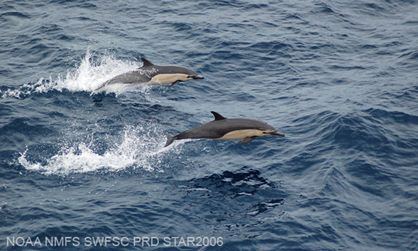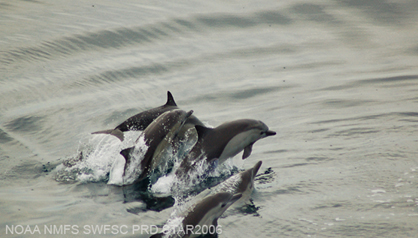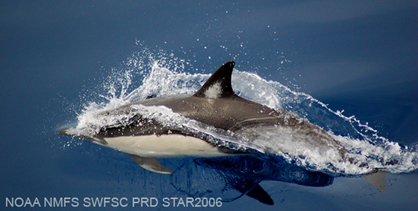Short-Beaked Common Dolphin (Delphinus delphis)
Status | Taxonomy | Species Description | Habitat | Distribution |
Population Trends | Threats | Conservation Efforts | Regulatory Overview |
Key Documents | More Info
Status
MMPA - Short-beaked common dolphins, like all marine mammals, are protected under the MMPA.
Taxonomy
Kingdom: Animalia
Phylum: Chordata
Class: Mammalia
Order: Cetacea
Family: Delphinidae
Genus: Delphinus
Species: delphis
The long-beaked common dolphin (Delphinus capensis) is another species of common dolphin.
Species Description
Short-beaked common dolphins are small dolphins under 9 ft (2.7 m) long and weigh about 440 lbs (200 kg). As adults, males are slightly larger than females. They have a rounded "melon", moderately long beak, and a sleek but robust body with a tall, pointed, triangular, "falcate" "dorsal" fin located in the middle of the back. This species can be identified by its distinct bright coloration and patterns. A dark gray cape extends along the back from the beak and creates a "V" just below the dorsal fin on either side of the body. There is a yellow/tan panel along the flank, between the dark cape and white ventral patch, forward of the dorsal fin. This bold coloration forms a crisscrossing "hourglass" pattern. A narrow dark stripe extends from the lower jaw to the flipper. There is also a complex color pattern on the facial area and beak that includes a dark eye patch. The coloration and patterns of young and juvenile dolphins are muted and pale, but become more distinguishable and bolder as they mature into adulthood. These morphologies can be variable and distinct based on different geographic and regional populations.
The long-beaked common dolphin is another species of common dolphin that appears similar to the short-beaked common dolphin. Both species are in the same genus, Delphinus. The two species differ slightly in physical size, features, coloration, and pattern. Long-beaked common dolphins generally prefer shallower and warmer waters closer to the coast when compared to short-beaked common dolphins. There is a separate unclarified subspecies/dwarf form of the short-beaked common dolphin in the Black Sea called Delphinus delphis ponticus, as well as a distinct tropical population/subspecies of the long-beaked common dolphin in the Indian Ocean and Southeast Asia region called Delphinus capensis tropicalis.
Short-beaked dolphins are usually found in large social groups averaging hundreds of individuals, but have occasionally been seen in larger herds consisting of thousands of animals (up to at least 10,000), which are known as "mega-pods." These large schools are thought to consist of sub-groups of 20-30 individuals that are possibly related or separated by age and/or sex. Short-beaked common dolphins are often active at the surface displaying various behaviors. These gregarious, energetic dolphins commonly breach, porpoise, "pitch-pole", somersault, and conduct other frequent surface active behaviors. They will often approach ships and even large whales to "bowride" for long periods of time.
Short-beaked common dolphins are capable of diving to at least 650 ft (200 m) to feed on fish from the deep scattering layer at night, and usually rest during the day. The majority of their prey is "epipelagic" schooling fish and cephalopods (e.g., squid). Short-beaked common dolphins commonly associate with schools of tuna and seabird feeding flocks, especially in the eastern tropical Pacific Ocean. They have also been observed in schools with spinner dolphins and striped dolphins. This species has 40-57 pairs of small sharp conical teeth in each jaw.
Males become sexually mature between 3-12 years and females between 2-7 years. Breeding usually takes place between the months of June and September, followed by a 10-11 month gestation period. Females give birth to a single calf that is about 2.5-3 ft (0.8-0.9 m) long, and have an estimated calving interval of 1-3 years. Calving can occur annually and lactation lasts approximately 4 months. They have an estimated lifespan of up to 35 years.
 Short-Beaked Common Dolphins (Delphinus delphis) Photo: Howard Goldstein, NOAA's Southwest Fisheries Science Center, STAR 2006 |
Habitat
Short-beaked common dolphins prefer warm tropical to cool temperate waters (52-88° F or 10-28° C) that are primarily oceanic and offshore, but still along the continental slope in waters 650-6,500 ft (200-2,000 m) deep. In the western North Atlantic, they are often associated with the Gulf Stream Current. Short-beaked common dolphins also prefer waters altered by underwater geologic features where upwelling occurs.
Distribution
The abundance and distribution of short-beaked common dolphins vary based on interannual changes, oceanographic conditions and seasons. They can occur on the continental shelf or farther offshore. Off the U.S. west coast, the majority of the populations are found off of California, especially during the warm-water months. Off the U.S. east coast, they are more common north of Cape Hatteras, North Carolina. During summer through autumn, large aggregations can be found near Georges Bank, Newfoundland, and the Scotian Shelf. Other distinct populations can be found off of northern Europe, the Black Sea, Newfoundland, the Mediterranean Sea, Africa, Japan, the southwestern Pacific, southern Australia, and New Zealand.
Population Trends
For management purposes, short-beaked common dolphins inhabiting U.S. waters have been divided into two stocks: the California/Oregon/Washington Stock and the Western North Atlantic Stock. Currently, off California, Oregon, and Washington, it is estimated that there are between 366,000-450,000 short-beaked common dolphins. The western North Atlantic stock is estimated between 100,000-121,000 animals. There are an estimated 100,000 off northwestern Europe, over 300,000 off western North America, and 3 million in the eastern Pacific. Populations of short-beaked common dolphins in the Black Sea and Mediterranean Sea have been depleted because of lack of prey due to over-hunting, fisheries interaction, and habitat degradation. Overall, this species is still abundant worldwide, except for a few specific populations. There are insufficient data for this species to determine the population trends.
 Short-Beaked Common Dolphin (Delphinus delphis) Photo: Howard Goldstein, NOAA's Southwest Fisheries Science Center, STAR 2006 |
Threats
Short-beaked common dolphins are incidentally taken in fishing gear that includes longlines, driftnets, gillnets, and trawls. They are commonly incidentally taken in a number of fisheries in the Atlantic Ocean. Historically, fishing operations, specifically the tuna purse seine industry in the eastern tropical Pacific, have killed significant numbers of short-beaked common dolphins. They have been directly hunted for their meat and oil in Russia, Japan, and by nations bordering the Black Sea and the Mediterranean Sea.
Conservation Efforts
The International Union for Conservation of Nature and Natural Resources (IUCN's) Red List of Threatened Species ![]() considers this species "Low Risk Least Concern," but the Mediterranean population is considered "Endangered."
considers this species "Low Risk Least Concern," but the Mediterranean population is considered "Endangered."
Regulatory Overview
This species is protected under the Marine Mammal Protection Act of 1972, as amended.
Key Documents
(All documents are in PDF format.)
| Title | Federal Register | Date |
|---|---|---|
| Stock Assessment Reports | n/a | various |
- NMFS Southwest Fisheries Science Center Common Dolphin Information
- NOAA's National Marine Sanctuaries
References:
- Reeves, R. R., P. A. Folkens, et al. (2002). Guide to Marine Mammals of the World. New York, Alfred A. Knopf. p.388-391.
- Jefferson, T. A, M. A. Webber, and R. L. Pitman. (2008). Marine Mammals of the World, A Comprehensive Guide to their Identification. Amsterdam, Elsevier. p. 245-248.
- Leatherwood, S., R. R. Reeves, et al. (1988). Whales, Dolphins, and Porpoises of the Eastern North Pacific and Adjacent Arctic Waters: A Guide to Their Identification. New York, Dover Publications, Inc. p.160-165.
- Perrin, W. F., B. Wursig, et al., Eds. (2002). Encyclopedia of Marine Mammals. San Diego, Academic Press. p.245-248.
- Shirihai, H. and B. Jarrett (2006). Whales, Dolphins and Other Marine Mammals of the World. Princeton, Princeton University Press. p.171-174.

